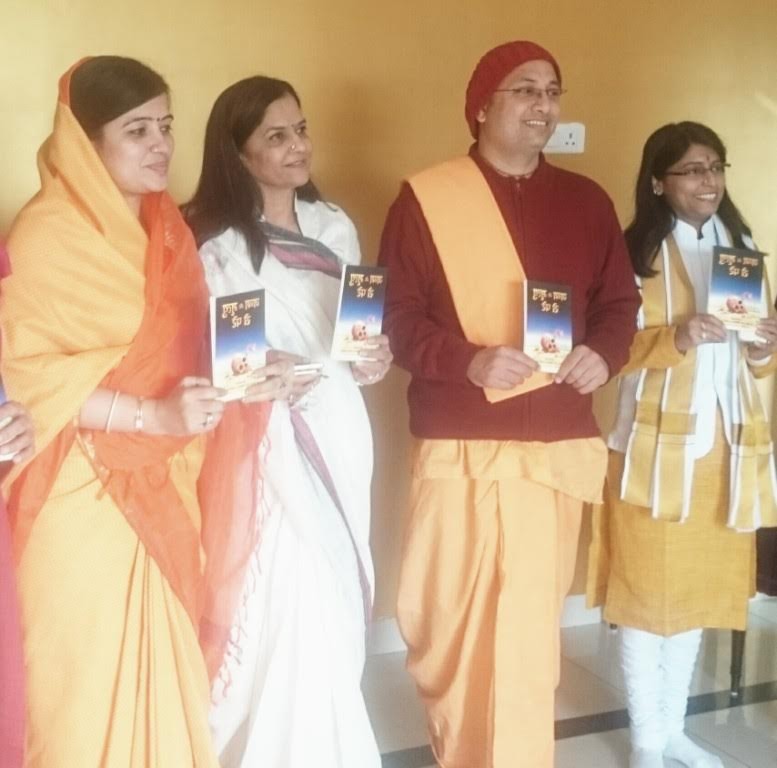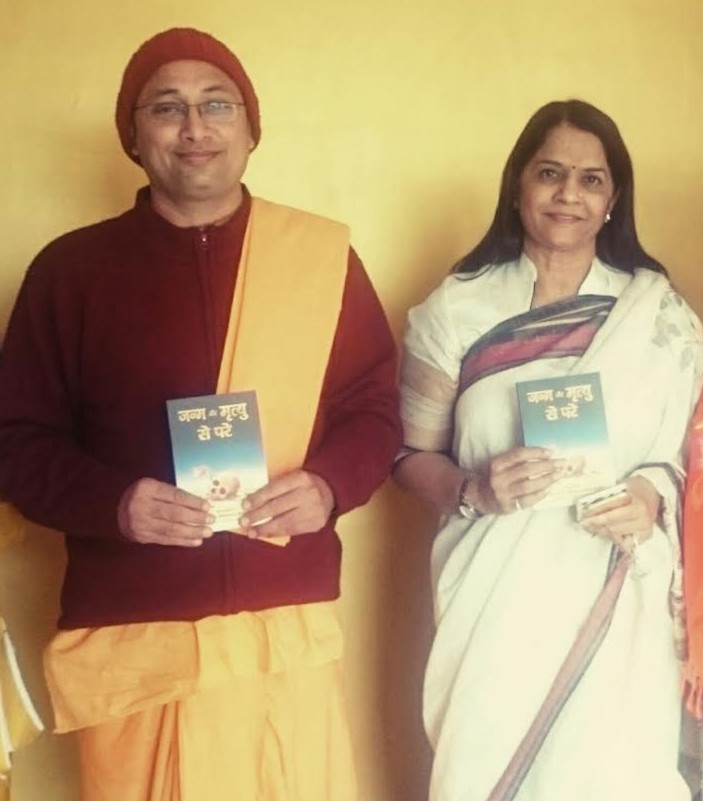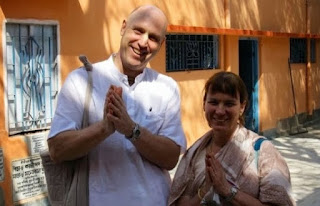
By Parvati devi dasi
Dear Maharajas and Prabhus, Please accept my humble obeisances. All glories to Srila Prabhupada. Once again, I wish to extend my thanks to so many of you who were inspired to come forward this year to help build up the Samadhi Maintenance Fund Fixed Deposit as well as the working account. We are halfway to the $200,000 goal. It is certainly Krishna’s blessing to have so much international participation in this wonderful service in Vrndavana Dhama. How can we ever pay our debt to Srila Prabhupada?
**So far:
1- We were finally able to install the “Changing Bodies” Diorama upstairs in the Museum complete with timed lights in the heart regions of the figures. Videos we took may be available with ITV Vrndavan, which will be up-graded soon. We were the first super event on the list of celebrations for Vrndavan Temple’s 40th Anniversary Festival. At the Diorama inauguration, on Vasant Panchami, Janardana Swami spoke very enthusiastically and laughed, “Now we have a Museum!” Bhima das spoke of the brilliant preaching to be done by these displays, citing the example of Bhaktisiddhanta Sarasvati Thakur’s Theosophical Diorama Display in Calcutta. Dioramas are so impactive; you don’t even have to know how to read the explicit descriptions to grasp the philosophy. Narahari das revealed that as soon as he saw a similar diorama in Juhu, he immediately headed for the book table for as many books as he could carry and became a full time devotee. Bhaktisiddhanta das, the original inventor of this diorama, noted that Srila Prabhupada wanted Diorama Museums in every temple because of the preaching potential. He is presently helping to organize the dioramas for the Mayapur planetarium. 4 are exactly the same dioramas previously approved (out of a total of 6) by the VEB for our Museum downstairs, before
(I’m sad to say) it was decided to continue with the mall. The diorama figures were donated by Jitarati das and the basic photo digitals were provided by Bangalore and modified to expand the message. Then we added a few perfect verses in steel signage on the platform. The very real looking artificial grass they all stand on was probably from Malaysia. Anyone who wants a copy of the digitals to make their own presentation for their temple is welcome to contact me. Really, every temple should have one of these.
2. WE REARRANGED PART OF THE TIMELINE displaced by the diorama up there. Later, we’ll catalogue what the maha photos are if anyone wants to give a token donation for them. We put Hindi translations of the framed English descriptions of the timeline photo display, steel plate nameplates for the Deities’ case, and also steel plate descriptions of the parampara on the pillars in front of them. Very handsome. We also replaced the kitchri of pictures ahead of you as you enter, with a huge 7′ x 7′ colorful picture of the ecstatic sankirtan party of the Panca Tattva, above the Six Goswamis and framed flex descriptions of the Yuga Dharma, Panca Tattva and the Sad Goswamis. The sun shines brilliantly onto this display most of the afternoon. Very effulgent.
3. We fixed a bunch of damaged carved marble and construction errors and replaced the curtains with beautiful maroon velvet.
4. A NEW SLIDING DOOR mechanism was installed for the Samadhi altar. Works a lot easier than the other one.
5. Vrndavan das (president of the Surat Temple) did a beautiful service by gold-plating various frames on the doors of the altar and baseboard under the inside all around the altar under the doors on the inside too.
6. Gardens: We had a wonderful monsoon and growing-season this year. So we were able to plant a lot of Night Queen (very fragrant at night and early morning) and Mehendi, which also has very fragrant flowers. They are growing prolifically, aren’t attractive to the monkeys, and will cover the boundary area on the roadside. Soon as they become available we will plant some more seasonal flowers that should last through Kartik and add a little color. We got a donation of 500 Freesia bulbs, which should bloom by Gaura Purnima.
7. Original entrance pillars to the Samadhi front gate on the boundary were re-clad with the carved marble we salvaged when the municipality had us move the boundary back. It’s simply beautiful.
8. The ladies kirtan group seems to be growing more and more popular. Visitors love sitting and chanting with them for Srila Prabhupada’s pleasure. Now they have started an afternoon session.
9. The Museum was meant for preaching. Although there were so many obstacles, we have steadily broadened our Free Temple Tour Program. It has diversified in amazing directions.
There are many arms on this body of campus preaching. We have an expanding Japa programme upstairs in the Samadhi, headed by MADHUSHRESTHA DAS, daily engaging hundreds of visitors in chanting a round of Hare Krishna Maha Mantra, the mantra of deliverance for the Age of Kali. You may remember BHAKTISIDDHANTA prabhu’s classic diorama reliefs upstairs in the Samadhi, which exhibit the pastimes of Srila Prabhupada with reference to the Samsara Prayers. Now there is a new exhibit of 39 Parampara Acaryas in the arches above Prabhupada’s altar, with appropriate descriptions of our Brahma Madhava Gaudiya Sampradaya on the upstairs parikrama walls. So there is a lot preaching the first floor and book distribution going on. There is limited space, but freedom of movement.
The results speak for themselves-ever-increasing. They need more volunteers to cover the time after 7 pm. So many people; so few preachers to meet them. Some individual devotees make their own hours and take groups on tours of the Samadhi, the diorama, Prabhupada’s House and the temple, or just pick a spot and preach to people coming in, like DEVANANDA PANDIT DAS, who continually takes out tours around Vrndavan/Braj, and Char Dham, among other places. That man has a variety of other preaching projects including Vedic special cooking classes using clay pots and cow dung as fuel. One of our Free Temple Tours ladies, VRNDAVANI DASI, meets people in the evenings coming for Samadhi darshan and gets them all to chant Hare Krishna-and they are so happy someone took the trouble to welcome them personally, beaming with smiles. Free brochures in Hindi and English are handed out to all.
Recently, a man from Punjab requested the Bhishma Dept. for the honor of sponsoring the printing of 25,000 of those. They finished, and we reprinted 30,000 more. CAITANYA CHAKRAVARTI DAS from the pujari department also organizes wonderful home programs in his spare time PERSONAL CONTACT PREACHING is very effective and very rewarding spiritually. It is the essence. It is a nice first impression for the pilgrims, as Peter Burwash would say-more interactive than standing behind shop table waiting for people to take out their wallets. Since the inauguration of the Changing Bodies Diorama upstairs in the Museum side, the NAMA HATTA preachers have organized 4-6 devotees to draw visitors upstairs, preach to them with the fabulous preaching tools of a diorama and the Movement’s time-line, sell more books and get them down to their office to become active participants in our process with lectures. It’s very exciting preaching. This is organized by RADHA SHYAMSUNDAR DAS (longtime prolific preacher) AND GOURANGA DAS (one of our stars from the humble beginnings of the Free Temple Tours). We hope the rest of the brahmacari ashram and community members catch this infection.
If everyone in the brahmacari ashram volunteered at least one hour of their time daily to this rewarding type of preaching, the ecstasy is unimaginable. When YOU visit Vrndavana, jump into this ocean of mercy yourself! The traveling kirtan program, headed by SARANGA DAS is invited to places all over the country, travels and distributes Hare Nama and so many books. They need to have a little more communication with the temple management, though, to refine the process and let us all share the enthusiasm of their preaching. The Rural Development Team has diversified into village self-sufficiency preaching, bus book distribution, medical and nutritional programs, khadi type products and more. INDRANEELAMANI DAS heads up this admirable program, in his spare time, in addition to his other services growing the Temples flowers and running the Bakery/Sweet shops which support a substantial portion of our Temple’s Finances, despite the inadequate facility it has. Who can estimate what he could do with the proper facility?
**Next few months we would be happy to accept inspired donations to cover the costs of the following projects: 1- Cover the costs of the Diorama ($6,000) . 2- The upstairs Museum photos of the Panchatattva and other signage ($200) 3- New fans ($300). 4- $3000 for the paramapara Deities glass house and signage 5- First floor Samadhi arch framed parampara acarya photos and description signage ($1000) 6- Garden development ($500)
**We always need (prices keep increasing): o $2,000 per month for cleaning, painting, general maintenance, gardening, etc. o $1,000 per year for continual stone polishing of the marble exterior and interior o $1,500 per year for up-grading exhibits o $1,500 per year for up-grading Prabhupada’s altar o $2,000 per year repairing damages caused by traffic, weather, pollution, age, etc.
**ANNUAL INCOME** from Sept.2014-Sept. 2015 1. The Vrndavana Samadhi Maintenance Fund now has about Rs.92,00,000 on Fixed Deposit, which gives 9% interest. These donations perpetually serve Srila Prabhupada with the interest. We now have the annual minimum costs, which don’t cover most special projects or repair costs. 2. Many devotees donated for special projects anonymously this year. We had one anonymous donor who donated Rs.90,000, and another over a lakh. 3. Hundi donations were Rs.5,200,029, double of last year. 4. Our larger donations mainly came from our Jagat Priya and Mandapa prabhus (ACBSP) from Australia, Vishnu Murti das’s wife Rohini devi dasi (donated in honor of her husband, former chairman of Mombasa Temple), Srivallabha das and the Dubai community; Prassannatma das, Tyaga Caitanya das from Malayasia, HH Kesava Bharati Swami HH Subhag Swami, and HH Dhanudhara Swami. Many others gave various amounts for which we thank you all for your generosity and commitment to our Founder-acarya’s working account and Fixed Deposits as well as specified projects. 5. Total donations: General Donation Rs. 6 lakhs Hundi Collection Rs. 5.3 laks Interest on FD Rs. 8 laks
**INCOME NEEDED** **WHAT YOU CAN DO**
We aim to build up a Fixed Deposit of $200,000 to use the interest for expenses in addition to the donations for new projects. This will cover inevitable costs and give an increased cushion for future surprises in the aging structure. Srila Prabhupada’s Vrndavana Samadhi Maintenance Fund needs you now! All participation is welcome. No donation is too large or too small. Please choose a convenient method for your personal service to Prabhupada’s Samadhi Mandir: 1. Annual commitments to the Fixed Deposit presently vary from $108, $501 to $1,001. 2. One-time donations as above. 3. Substantial donations to any of the above on-going projects for the working account. 4. We have a lot of leftover marble now situated in a pile near the Goshala entrance. If you know someone with a project, tell them to take a look. Or if you just want a piece for a souvenir, take something and give from the heart to the Samadhi Hundi, unless you want a receipt. 5. We also have pewter German Silver) medallions for a donation of Rs.1,000, varieties of Maha velvet curtains and bolsters and carved teak originally meant for the arch behind the Deity; retired photo blowups. They will be available at the different Deity Maha-tables during festivals, or just contact me. 6. We also have stone tiles, originally from the front of Srila Prabhupada’s house, and also some from the veranda and steps between Prabhupada’s room and kitchen at the Radha Damodar Temple. His Divine Grace would have walked on them thousands of times. For that, you have to meet me personally and name your price.
**HOW TO HELP** Whether you wish to give to the Vrndavana Samadhi Fixed Deposit, or to some specific project of the Samadhi, contact me please
(parvati.acbsp@pamho.net) here in Vrndavana. I will let you know the easiest and least complicated way to send your donation, and will be very happy to answer any other questions you may have. There is probably one of our reliable representatives near you who can carry your generous donations directly to Vrndavana. Recently, the temple changed some accounts to Axis Bank Ltd. So some of the old information listed on previous Newsletters and all our 5,000 brochures is now updated as follows: o Samadhi rupee donations for sending money locally or abroad: o To ISKCON Vrndavana, SBI ac#10684301765, IFC code: DSBIN0016533 o Foreign donations to AXIS Bank A/c #910000100-145-5239 Swft code: AXISINBB086 I FSC code: UTIB0000794
o On-line donation iskconvrindavan..com click option of online donation
o US Tax exemption: www.vedic-cf.org
Try not to send foreign checks. They take forever to process. However you do it, communicate it to me so I know to look for it in case of technical delays. Easiest is to wire to our bank, send cash directly, or even an international money order with some reliable person. To insure appropriate handling, address your envelope to Samadhi Maintenance Fund, attention Parvati devi dasi WITH A COVERING LETTER. You can also e-mail me. Please state your name, address and the purpose of the donation, so proper documentation can be made and receipts can be sent along with special gifts. Kindly specify that your donation is for the Samadhi, either a special Samadhi project, for the Samadhi Fixed Deposit or in general for the Samadhi working expenses. I thank all of you for helping me to serve the Samadhi better and beg to remain
Your servant, Parvati devi dasi, Samadhi Office.



















 By Urmila Devi Dasi
By Urmila Devi Dasi










 By Mahatma Das
By Mahatma Das